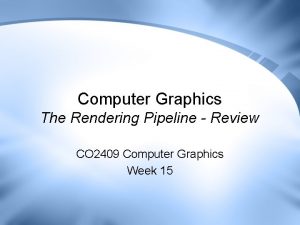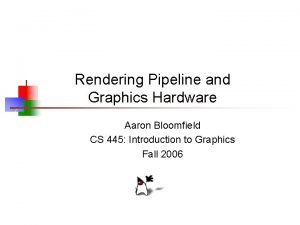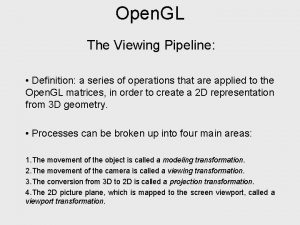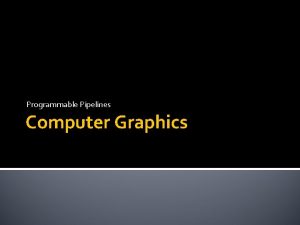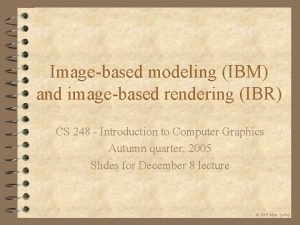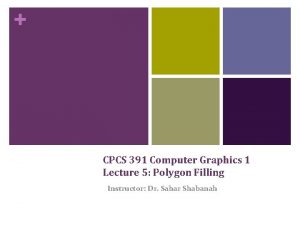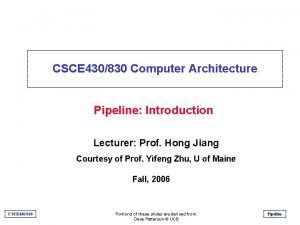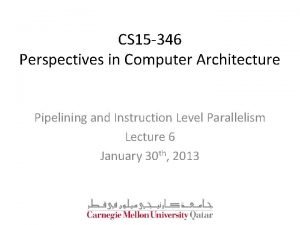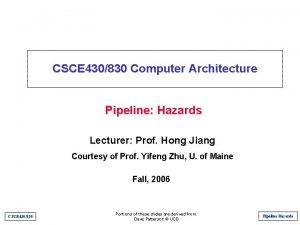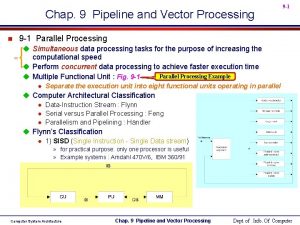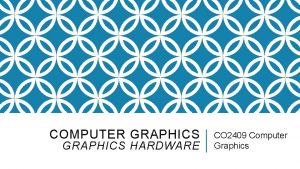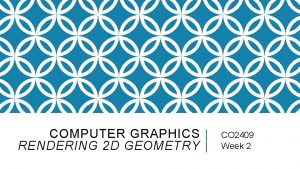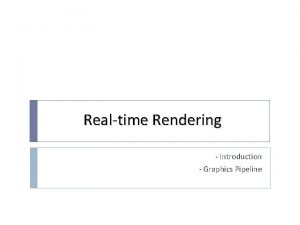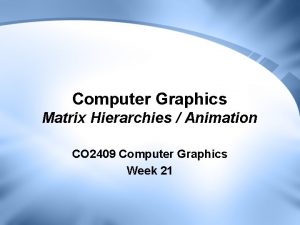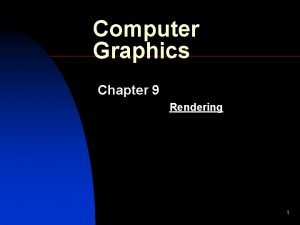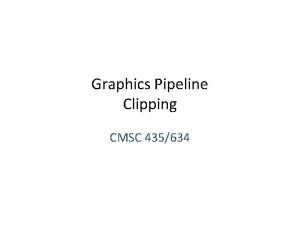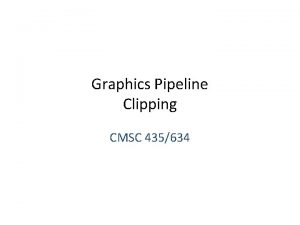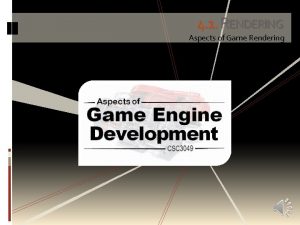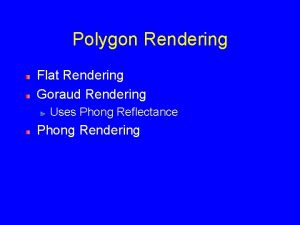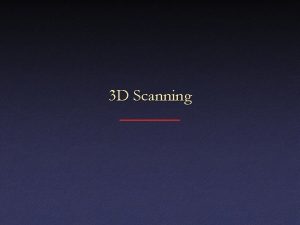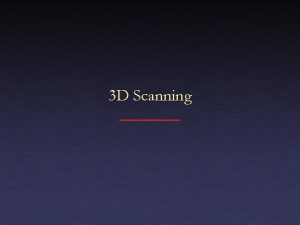COMPUTER GRAPHICS THE RENDERING PIPELINE REVIEW CO 2409
















- Slides: 16

COMPUTER GRAPHICS THE RENDERING PIPELINE REVIEW CO 2409 Week 15

LECTURE CONTENTS 1. The Rendering Pipeline 2. Input-Assembler Stage Vertex Data & Primitive Data 3. Vertex Shader Stage Matrix Transformations Lighting 4. Rasterizer Stage 5. Pixel Shader Stage Textures 6. Output-Merger Stage

THE RENDERING PIPELINE We looked at the rendering pipeline of Direct. X: We have seen all the key stages now But Geometry Shaders and Stream-Ouput are beyond the scope of the module Today we recap each stage Before moving on to some much more advanced material over the next few weeks

INPUT-ASSEMBER STAGE The Input-Assembler stage collects together the vertexes and indexes used in the geometry The key input data are the vertex coordinates of our geometry (X, Y, Z) position for each vertex Other parts of the pipeline also need additional per-vertex data: Vertex normals if using lighting to find colour at vertex Vertex colours if not using lighting Texture coordinates / UVs if we use textures Multiple sets if we blend multiple textures

VERTEX DATA FORMATS We have seen that the input vertex data is more than just a list of vertex positions Additional data required depending on how we intend to render the model With textures, lighting etc. We use custom vertex data formats for flexibility Different syntax in C++ and HLSL, but important to realise this refers to same data: the original geometry ready for the pipeline // C++ structure struct Basic. Vertex { D 3 DXVECTOR 3 Position; D 3 DXVECTOR 3 Normal; D 3 DXVECTOR 2 UV; }; // Matching HLSL structure struct VS_INPUT { float 3 Position : Position; float 3 Normal : Normal; float 2 UV : UV; };

VERTEX BUFFERS A vertex buffer is just an array of vertices Defining the set of vertices in our geometry Each vertex in a custom format as above The buffer is managed by Direct. X We must ask Direct. X to create and destroy them… …and to access the data inside The array is usually created in main memory then copied to video card memory Need it on the video card for performance reasons First saw vertex buffers in the week 5 lab

PRIMITIVES / INDEX BUFFERS The vertex data just defines points We usually want to define triangles in the geometry Or other primitives, e. g. lines The vertex data alone can define the primitives Each triplet of vertices defining a triangle Or we can use an index buffer An simple array of integers that index the vertex buffer A triplet of indexes for each triangle No duplication of vertices Saw index buffers in week 9 Index Buffer Vertex Buffer 0 1 2 3 We have also seen triangle strips Reuses previous vertices, works with or without an index buffer Vertex 0 Vertex 1 Vertex 2 Vertex 3

VERTEX SHADER STAGE The vertex / index data defines the 3 D geometry Next step is to convert this data into 2 D polygons We use vertex shaders for this vertex processing The key operation is a sequence of matrix transforms Transforming vertex coordinates from 3 D model space to 2 D viewport space The vertex shader can also calculate lighting (using the vertex normals), perform deformation etc. Although we will shift lighting to the pixel shader next week Some vertex data (e. g. UVs) is not used at this stage and is simply passed through to later stages

FROM MODEL TO WORLD SPACE The original geometry is stored in model space A local space with a convenient origin and orientation Each model has a world matrix That transforms the model geometry from model space to world space: This matrix defines position and orientation for the model Has a special form containing the local axes of the model These axes are often extracted from the matrix

FROM WORLD TO CAMERA SPACE We view the models through a camera Which is part of the scene A camera has a view matrix Transforms the world space geometry into camera space Camera space defines the world as seen by the camera Camera looks down its Z axis The view matrix is the inverse of a normal world matrix We often store a world matrix for the camera and just invert it as a final step Allows us to treat a camera like a model

CAMERA SPACE TO VIEWPORT Each camera has a second matrix, the projection matrix Defining how the camera space geometry is projected into 2 D Defines the camera’s field of view And the distance to the viewport Often called the near clip distance Final step is to scale the projected 2 D geometry into viewport pixel coordinates Performed internally by Direct. X Covered this material weeks 6 -9

LIGHTING We looked at the mathematical method to illuminate 3 D geometry (week 11) We showed how lighting can be calculated while vertices are being transformed In the same vertex shader The calculations need a normal for each vertex Which also needs to be transformed into world space Because the lights are in the world Several effects combined for final vertex colour: Ambient, diffuse, specular We showed how to implement their formulae

RASTERIZER STAGE This stage processes 2 D polygons before rendering: Off-screen polygons are discarded (culled) Partially off-screen polygons are clipped Back-facing polygons are culled if required (determined by clockwise/anti-clockwise order of viewport vertices) These steps occur by setting states Saw states in week 14 blending lab This stage also scans through the pixels of the polygons Called rasterising / rasterizing Calls the pixel shader for each pixel encountered Data output from earlier stages is interpolated for each pixel 2 D coordinates, colours, UVs etc.

RASTERISATION • The Rasterization Stage scans the 2 D triangle geometry to determine all the pixels within • The Pixel Shader stage is called for each pixel found • The data passed to the Pixel Shader is interpolated (blended) from the output data of the three vertices from the triangle • This way each pixel gets slightly different data and effects are smoothed across the triangle surface

PIXEL SHADER STAGE Next each pixel is worked on to get a final colour The work is done in a pixel shader Texture coordinates (UVs) map textures onto polygons UV data will have been passed through from the previous steps Textures are provided from the C++ via shader variables Textures can be filtered (texture sampling) to improve their look Textures covered in week 12 Texture colours are combined with lighting or polygon colours to produce final pixel colours

OUTPUT-MERGER STAGE The final step in the rendering pipeline is the rendering of the pixels to the viewport Don’t always copy the pixels directly, because the object we’re rendering may be partly transparent This involves blending the final polygon colour with the existing viewport pixel colours Saw this in the Week 14 lab Similar to sprite blending Also the depth buffer values are tested / written We saw the depth buffer in the week 8 lab Will see them in more detail shortly
 Computer graphics pipeline
Computer graphics pipeline Rfc2409
Rfc2409 Rendering pipeline
Rendering pipeline Define viewing pipeline
Define viewing pipeline Programmable pipeline in computer graphics
Programmable pipeline in computer graphics Forma urbis
Forma urbis Graphics rendering
Graphics rendering Graphics monitors and workstations
Graphics monitors and workstations 3d viewing devices in computer graphics ppt
3d viewing devices in computer graphics ppt Linear pipelining
Linear pipelining Pipelining and superscalar techniques
Pipelining and superscalar techniques Pipeline in computer architecture
Pipeline in computer architecture Scalar pipeline in computer architecture
Scalar pipeline in computer architecture Structural hazards solution
Structural hazards solution Pipeline processing in computer architecture
Pipeline processing in computer architecture Pipeline and vector processing
Pipeline and vector processing Computer vision pipeline
Computer vision pipeline
